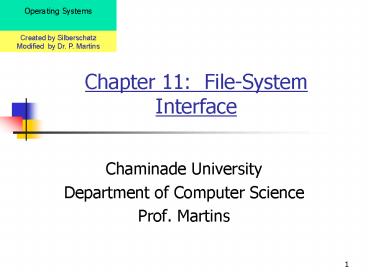Chapter 11: FileSystem Interface PowerPoint PPT Presentation
1 / 38
Title: Chapter 11: FileSystem Interface
1
Chapter 11 File-System Interface
Operating Systems
Created by SilberschatzModified by Dr. P.
Martins
- Chaminade University
- Department of Computer Science
- Prof. Martins
2
Contents
- File Concept
- Access Methods
- Directory Structure
- File System Mounting
- File Sharing
- Protection
3
File Concept
- Contiguous logical address space
- Types
- Data
- numeric
- character
- binary
- Program
4
File Structure
- None - sequence of words, bytes
- Simple record structure
- Lines
- Fixed length
- Variable length
- Complex Structures
- Formatted document
- Relocatable load file
5
File Structure
- Can simulate last two with first method by
inserting appropriate control characters. - Who decides
- Operating system
- Program
6
File Attributes
- Name only information kept in human-readable
form. - Type needed for systems that support different
types. - Location pointer to file location on device.
- Size current file size.
7
File Attributes
- Protection controls who can do reading,
writing, executing. - Time, date, and user identification data for
protection, security, and usage monitoring. - Information about files are kept in the directory
structure, which is maintained on the disk.
8
File Operations
- Create
- Write
- Read
- Reposition within file file seek
- Delete
- Truncate
9
File Operations
- Open(Fi) search the directory structure on disk
for entry Fi, and move the content of entry to
memory. - Close (Fi) move the content of entry Fi in
memory to directory structure on disk.
10
File Types Name, Extension
11
Access Methods
- Sequential Access
- read next
- write next
- reset
- no read after last write
- (rewrite)
12
Access Methods
- Direct Access
- read n
- write n
- position to n
- read next
- write next
- rewrite n
- n relative block number
13
Sequential-access File
14
Simulation of Sequential Access on a
Direct-access File
15
Example of Index and Relative Files
16
Directory Structure
Directory
Files
F 1
F 2
F 3
F 4
F n
Both the directory structure and the files reside
on disk. Backups of these two structures are kept
on tapes.
17
Directory Structure
- A collection of nodes containing information
about all files.
18
A Typical File-system Organization
19
Information in a Device Directory
- Name
- Type
- Address
- Current length
- Maximum length
- Date last accessed (for archival)
- Date last updated (for dump)
- Owner ID (who pays)
- Protection information (discuss later)
20
Operations Performed on Directory
- Search for a file
- Create a file
- Delete a file
- List a directory
- Rename a file
- Traverse the file system
21
Organize the Directory (Logically) to Obtain
- Efficiency locating a file quickly.
- Naming convenient to users.
- Two users can have same name for different files.
- The same file can have several different names.
- Grouping logical grouping of files by
properties, (e.g., all Java programs, all games,
)
22
Single-Level Directory
- A single directory for all users.
Naming problem Grouping problem
23
Two-Level Directory
- Separate directory for each user.
- Path name
- Can have the same file name for different user
- Efficient searching
- No grouping capability
24
Tree-Structured Directories
25
Tree-Structured Directories (Cont.)
- Efficient searching
- Grouping Capability
- Current directory (working directory)
- cd /spell/mail/prog
- type list
26
Tree-Structured Directories
- Absolute or relative path name
- Creating a new file is done in current directory.
- Delete a file
- rm ltfile-namegt
- Creating a new subdirectory is done in current
directory. - mkdir ltdir-namegt
- Example if in current directory /mail
- mkdir count
Deleting mail ? deleting the entire subtree
rooted by mail.
27
Tree-Structured Directories
28
Acyclic-Graph Directories
- Have shared subdirectories and files.
29
Acyclic-Graph Directories
Continued
- Two different names (aliasing)
- If dict deletes list ? dangling pointer.
- Solutions
- Backpointers, so we can delete all
pointers.Variable size records a problem. - Backpointers using a daisy chain organization.
- Entry-hold-count solution.
30
General Graph Directory
31
General Graph Directory (Cont.)
- How do we guarantee no cycles?
- Allow only links to file not subdirectories.
- Garbage collection.
- Every time a new link is added use a cycle
detectionalgorithm to determine whether it is OK.
32
File System Mounting
- A file system must be mounted before it can be
accessed. - A unmounted file system (I.e. Fig. 11-11(b)) is
mounted at a mount point.
33
(a) Existing. (b) Unmounted Partition
34
Mount Point
35
File Sharing
- Sharing of files on multi-user systems is
desirable. - Sharing may be done through a protection scheme.
- On distributed systems, files may be shared
across a network. - Network File System (NFS) is a common distributed
file-sharing method.
36
Protection
- File owner/creator should be able to control
- what can be done
- by whom
- Types of access
- Read
- Write
- Execute
- Append
- Delete
- List
37
Access Lists and Groups
- Mode of access read, write, execute
- Three classes of users
- RWX
- a) owner access 7 ? 1 1 1 RWX
- b) group access 6 ? 1 1 0
- RWX
- c) public access 1 ? 0 0 1
38
Access Lists and Groups
- Ask manager to create a group (unique name), say
G, and add some users to the group. - For a particular file (say game) or subdirectory,
define an appropriate access.

